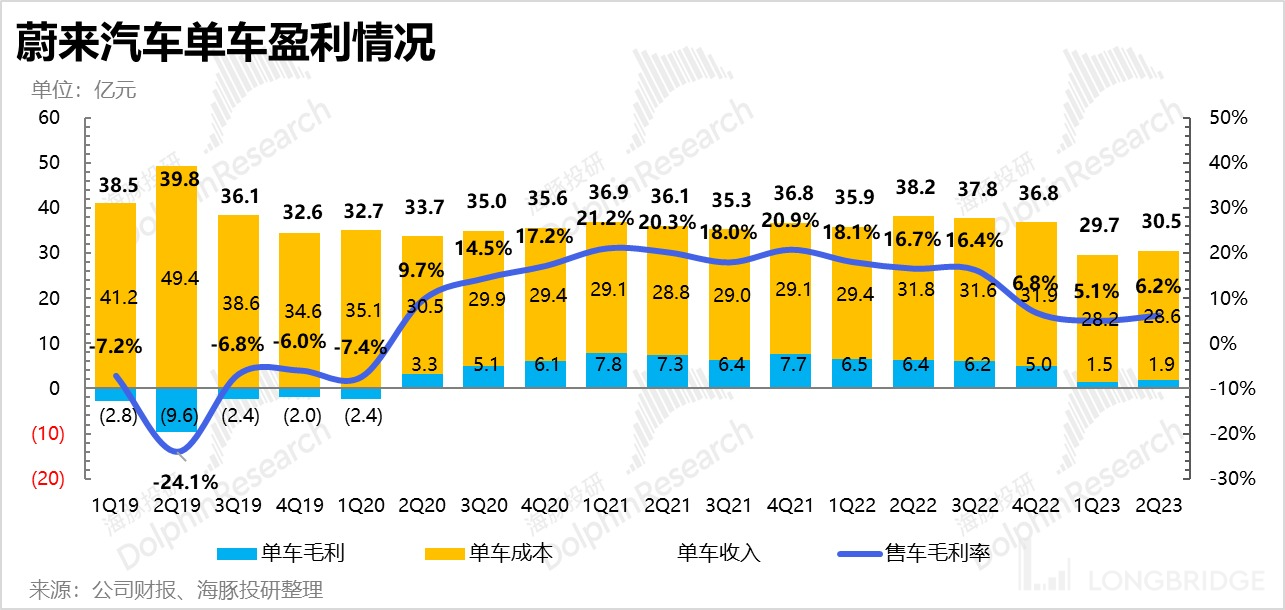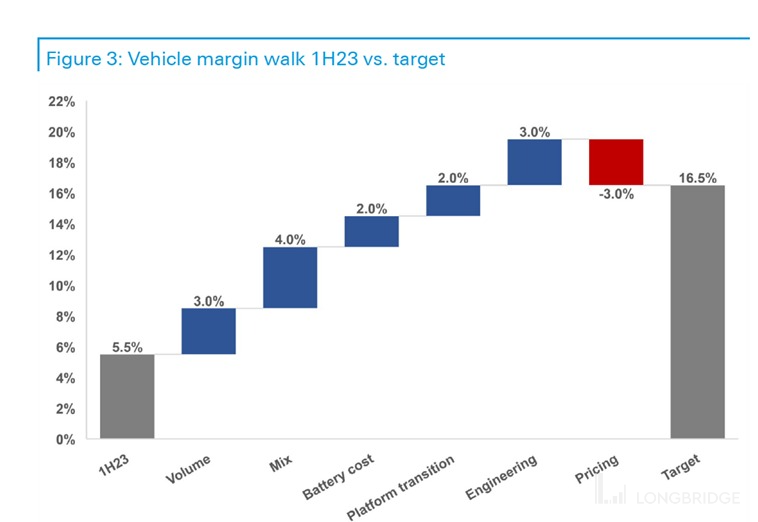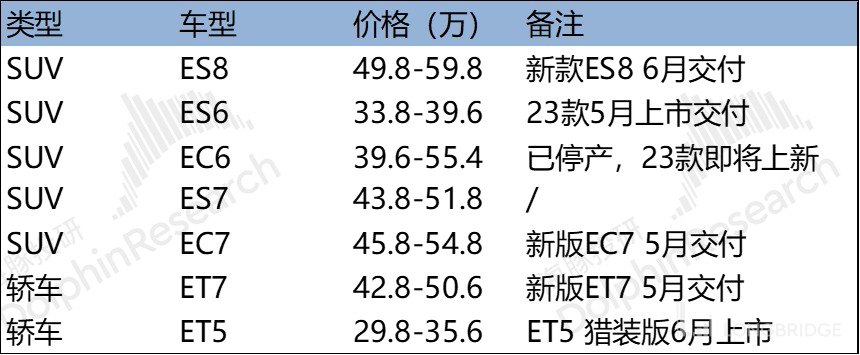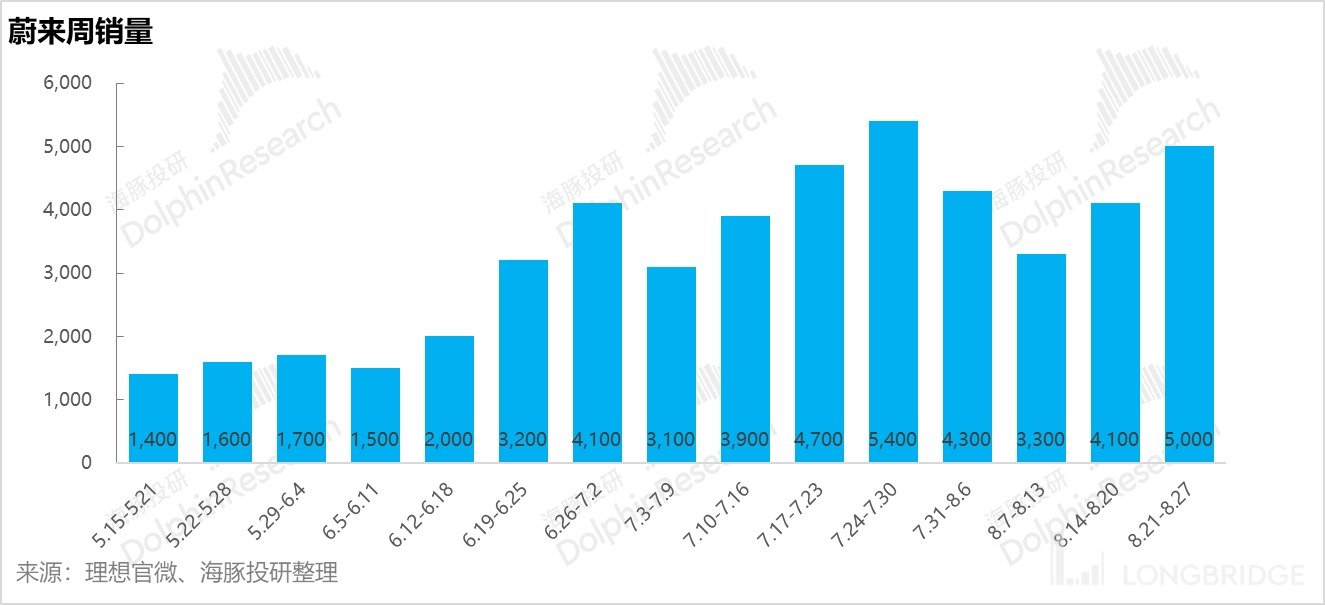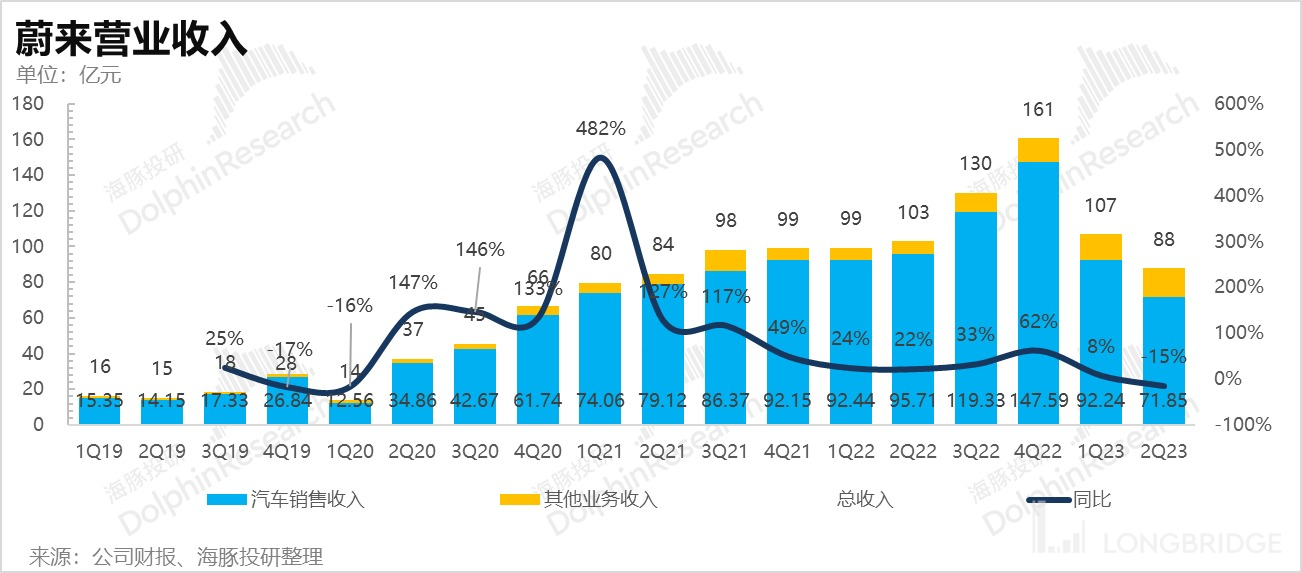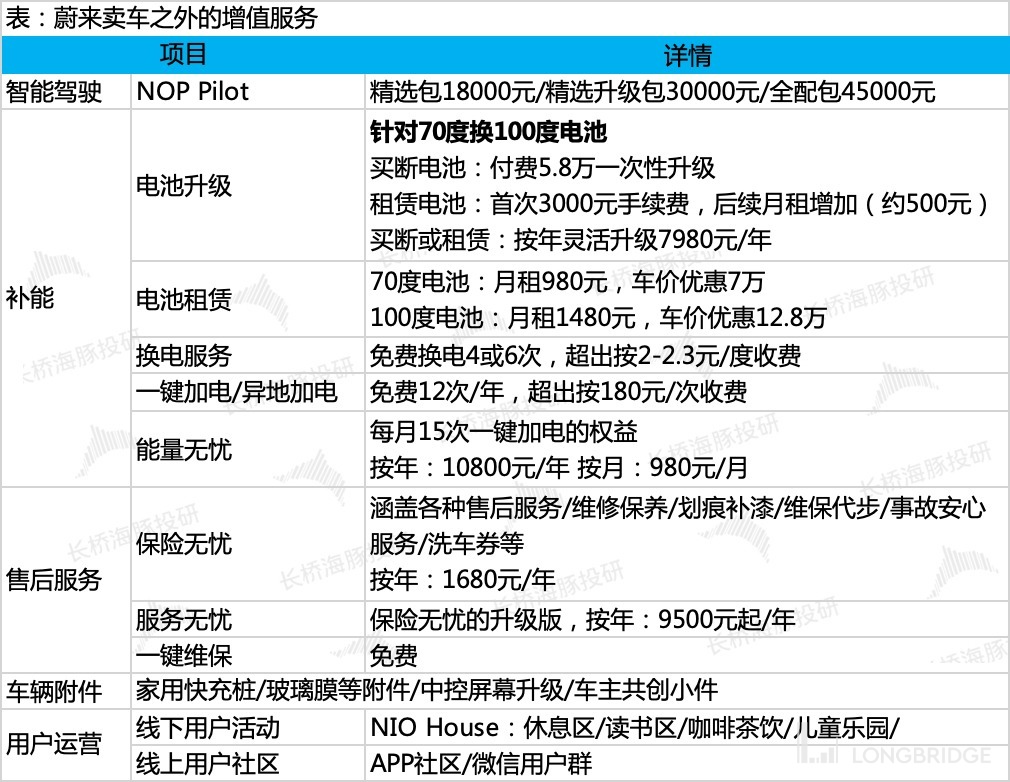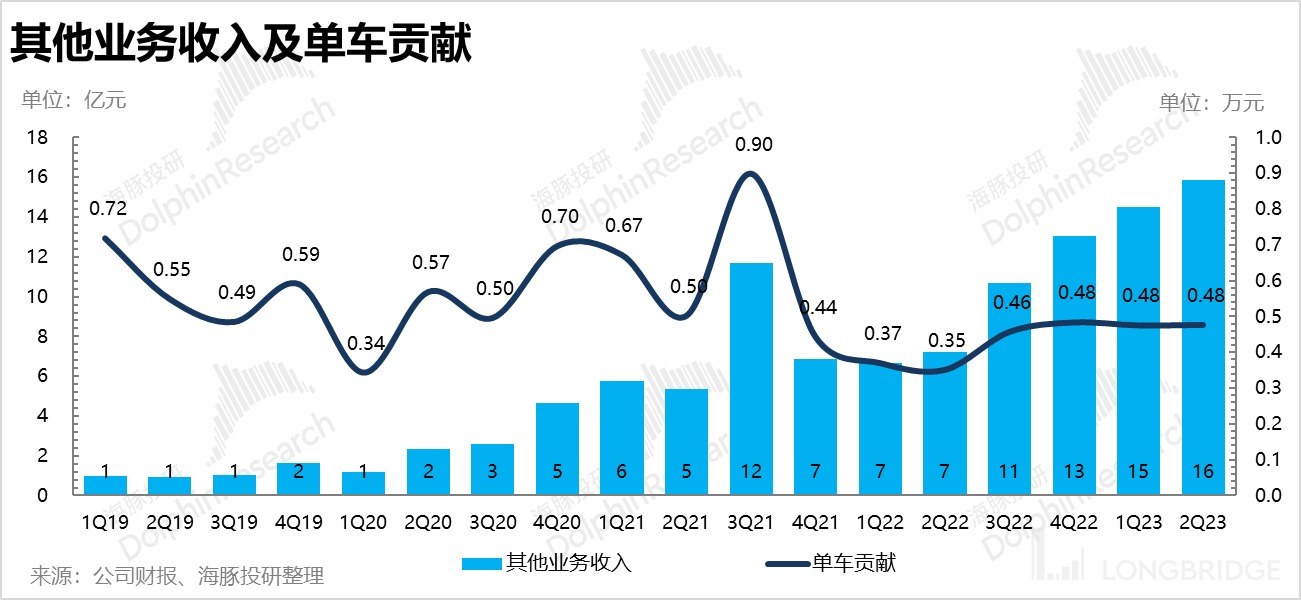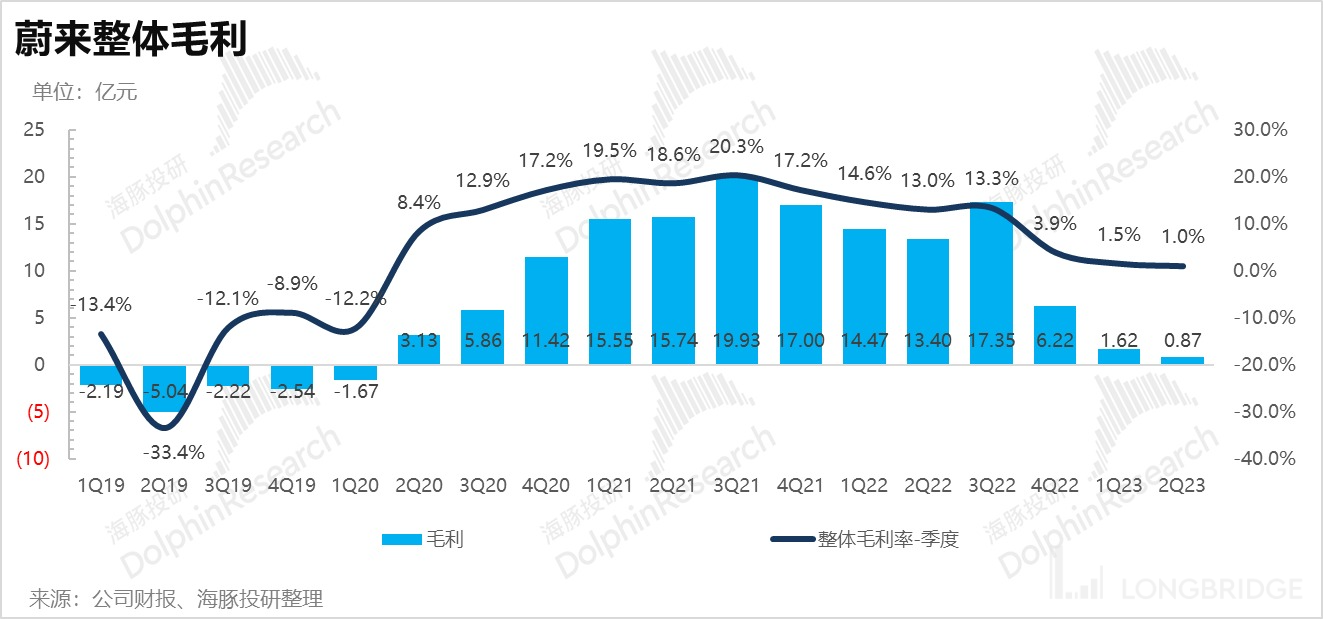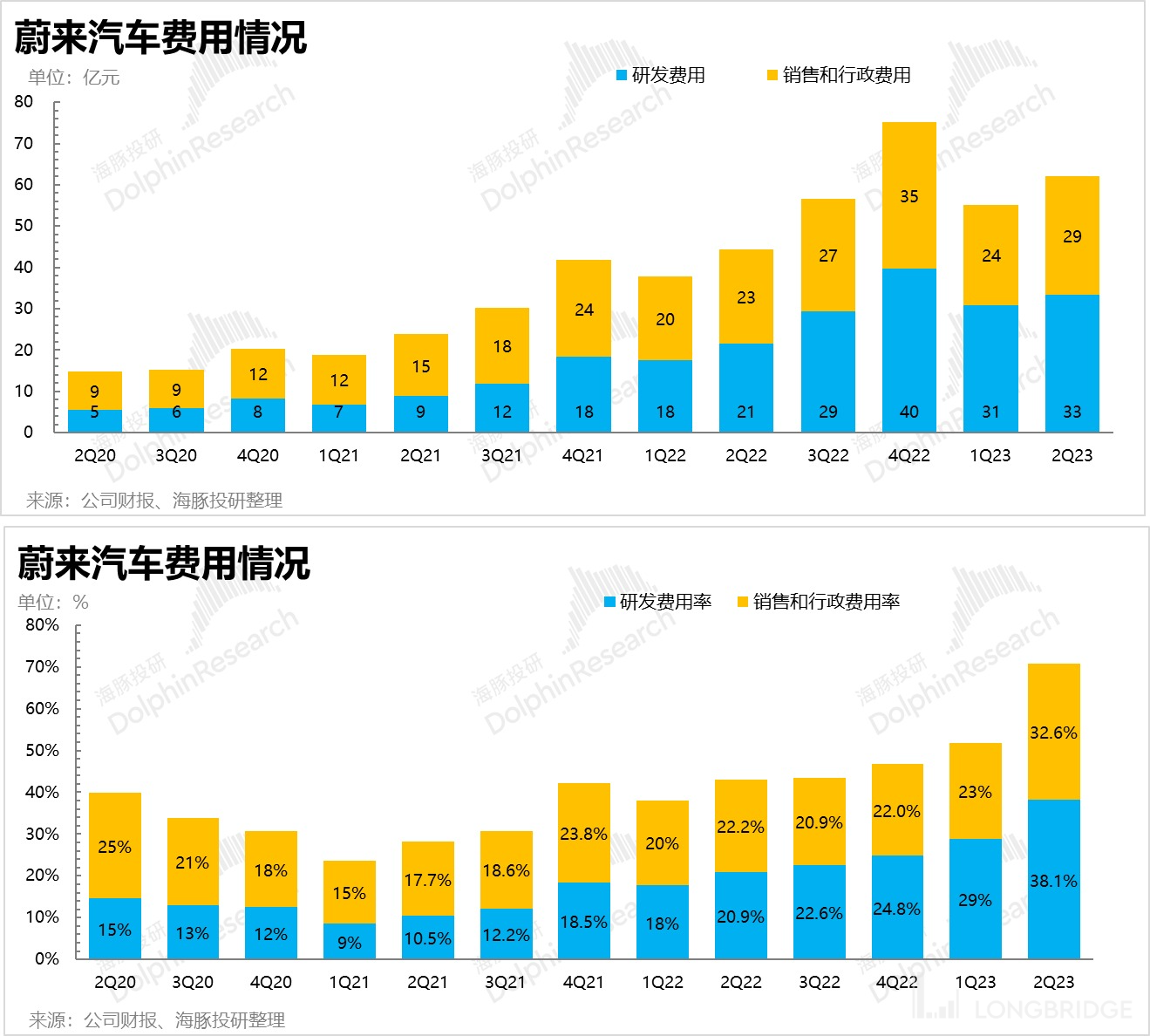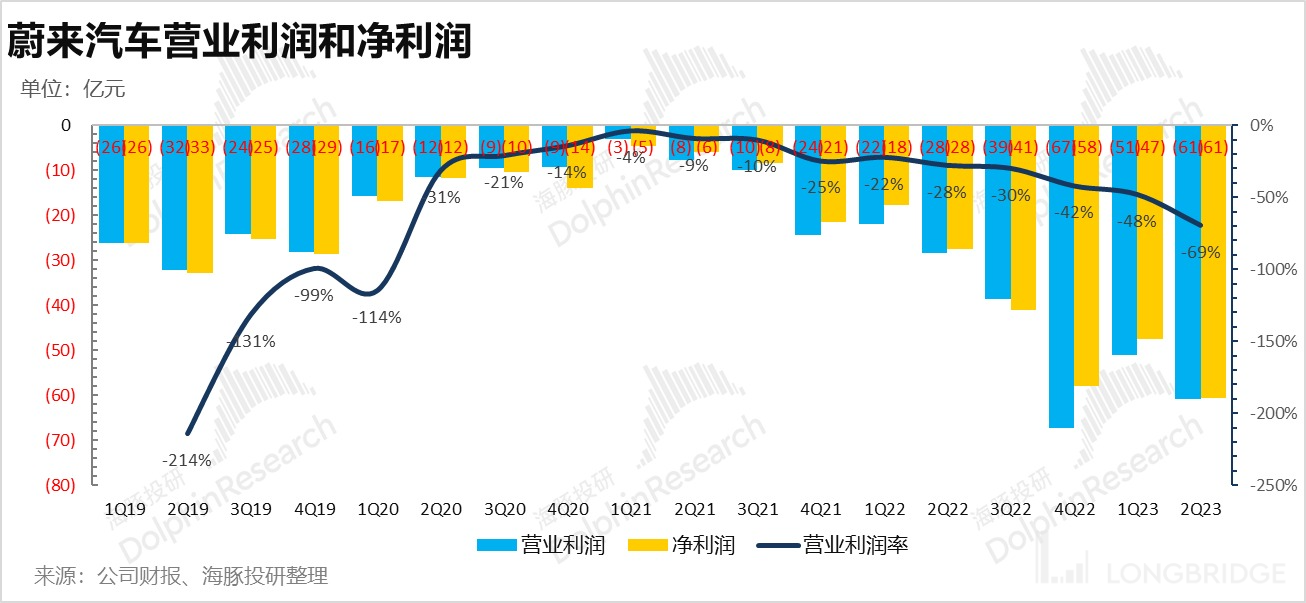
 Likes Received
Likes Received Posts
PostsNIO: Quarterly Loss of 6 Billion? Don't lose hope, the future is not too far away.

NIO.N released its Q2 2023 earnings report before the US stock market opened on August 29th. With a staggering loss of 6 billion behind it, the company faced embarrassing sales figures, a continuous decline in gross profit margin, and a mismatch between revenue and expenses. Let's take a closer look:
1. The fundamental issue lies in the price per vehicle: Total revenue was 8.8 billion, once again lower than market expectations. The main reason is intense price competition, which resulted in insufficient recovery of overall vehicle prices. The average price per vehicle only reached 305,000 yuan, significantly lower than market expectations.
2. Insufficient recovery in gross profit margin from vehicle sales: Due to the low vehicle prices, the gross profit margin from vehicle sales only increased from 5.1% in the previous quarter to 6.2%, once again lower than the market's expectation of around 7.7%. Although the proportion of ES6 in Q2 increased, the low gross profit margin of ET5 and the ongoing platform upgrade process affected NIO's capacity utilization.
3. Slightly disappointing guidance: The sales guidance for Q3 is 55,000 to 57,000 vehicles, lower than Dolphin Research's expectation of 60,000 vehicles. Since sales in July already exceeded 20,000 vehicles, it implies that sales in August and September may decline marginally. The company explained that this is due to the diminishing effect of battery swapping, coupled with macroeconomic pressures. Therefore, a conservative estimate was given, and the sales guidance for the two flagship models was lowered from 20,000 to a range of 15,000 to 20,000 vehicles.
As for the revenue guidance for Q3, with an implied vehicle price recovery of 189 to 195 billion yuan, the increase is not significant. The average vehicle price is only 320,000 yuan, indicating that the recovery in gross profit margin may not be substantial. However, due to the significant increase in sales volume and the continuous decline in the price of lithium carbonate, NIO's high battery capacity may allow the gross profit margin to reach the low teens, as the company stated.
4. Cash burn continues: During the vehicle replacement cycle, NIO launched many new vehicles in the previous quarter, resulting in low sales. However, the corresponding marketing and sales expenses were very high. In addition, NIO's research and development expenses have been growing rapidly, leading to a serious mismatch between revenue and expenses. As a result, the operating leverage in this quarter reached its worst level in the past three years. The high operating expenses contributed to a loss of 6 billion in Q2, which is more than 1 billion higher than the market's expectation. The main difference lies in the expenditure on operating expenses.

Dolphin Research's overall view:
Overall, NIO's Q2 performance is similar to that of Xiaopeng Motors, with no surprises and even disappointing sales guidance. Combined with relatively low gross profit margins and the lack of optimistic signals in the revenue guidance for the next quarter, the situation is concerning.However, from the perspective of marginal changes, we can see some signs of improvement in the issues that Dolphin Research previously mentioned about NIO. For example:
1) Dolphin Research mentioned that NIO needs to make reductions: In June, NIO unbundled its battery swapping service sales and vehicle sales, which resulted in a release of vehicle sales volume. Furthermore, considering the current cash flow situation, NIO expressed its intention to focus more on core business investments, while investments with weaker relevance to the automotive industry will slow down.
2) Dolphin Research mentioned that NIO's marketing, promotion, and delivery are still in the era of supply-oriented strategy: Looking at the release, sales, and delivery pace of the ES6 and ET5 in the second quarter, NIO has made significant progress and improved its pace, which should effectively prevent order diversion. Additionally, during the conference call, NIO reflected on the fact that its sales volume per salesperson is significantly lower than that of its competitors. As a result, NIO plans to deploy sales personnel and expand its network at a rate of 30,000 units per month.
Of course, behind the significant decline in other income gross margin, including issues related to used cars and battery swapping, Dolphin Research believes that there are still problems of "excessive service" to users and declining economic benefits. These issues will need to be continuously adjusted in the future, including reflecting on the investment in battery swapping.
However, with the recent $740 million investment from Middle Eastern tycoons, combined with NIO's current cash assets of around 30 billion RMB, NIO no longer has a cash flow problem. Despite the 45% drop in stock price and the negative impact of tonight's poor gross margin and lower-than-expected guidance, Dolphin Research believes that after this drop in stock price, there will also be opportunities for NIO. The stock price is expected to recover to a range of $16-19, which is Dolphin Research's neutral expectation.
However, due to the aforementioned long-term issues, NIO's upward potential and stability of the stock price after recovery may not be as great as that of Xiaopeng Motors. Moreover, in the external circle of friends, compared to Xiaopeng Motors' cooperation with Volkswagen, close relationship with NVIDIA, and partnership with Didi, NIO's positive prospects in this regard may be relatively limited. After all, due to the adoption of the battery swapping path, NIO's current vehicle platform is relatively inflexible and lacks compatibility with traditional automotive brands, which may hinder substantial cooperation or integration.
The following is a detailed analysis:
I. Selling cars to make money is still a challenge for NIO
As the most critical indicator every time the financial report is released, let's first look at NIO's profitability in vehicle sales.
We know that in the first quarter, NIO's gross margin plummeted to only 5% due to clearing out old models with various price reductions. Initially, the market believed that in the sales structure of the second quarter, where the ES6 starting at 330,000 RMB and the new ET5 priced close to 300,000 RMB accounted for the majority, the gross margin of vehicle sales could be restored to between 7-8%.
However, the actual gross margin of NIO's automotive sales business in the second quarter was only 6.2%, once again lower than market expectations.
If we look at the economics of individual vehicles, the problem is clearly related to the price of each vehicle:
- In the second quarter, the average price of NIO's vehicles was only 305,000 RMB, with an increase of only 8,300 RMB compared to the previous quarter, which is significantly lower than the market's expected 330,000 RMB.
- The cost per bike in the same period increased by 4,400 yuan compared to the previous quarter, which indeed brings some upward potential for gross profit, but it only raises the gross profit per bike from 15,000 to 19,000 yuan.
It should be noted that as a luxury electric vehicle, NIO's gross profit per bike before the fourth quarter of last year was basically the selling price of a low-priced car sold by others, rarely below 60,000 yuan. The profit from selling a bike that costs less than 20,000 yuan is almost negligible compared to the sales expenses incurred.
In the past quarters, even during good performance, NIO's R&D, sales, and administrative expenses per bike were rarely below 100,000 yuan.

Another point to clarify here is that in early June, NIO adjusted the prices of new cars and the rights to use them (including a 30,000 yuan price reduction for the entire new ES6 series and changing the free battery swapping service for first-time owners to a pay-per-use model). In essence, it decoupled the sale of services (battery swapping) from the sale of products (cars), each with its own pricing.
After the adjustment, those who do not want to use the battery swapping service pay less, which accelerates the release of sales volume. However, this adjustment should not have a significant impact on the price per bike according to current accounting standards. Even before the adjustment, although NIO sold cars and services together, the revenue from selling cars and services was recognized separately and in different projects, so it should not have a significant impact.

Can selling cars be profitable in the second and third quarters?
This question can be answered by looking at the company's guidance: the company expects sales volume in the third quarter to be between 55,000 and 57,000, which seems to be much higher than the market expectations provided by Bloomberg's sell-side analysts. However, these expectations are outdated and no longer relevant.
Based on recent market expectations seen by Dolphin Research, the sales volume is generally estimated to be around 20,000 per month and 60,000 for the third quarter, which is slightly lower than the market expectations. The company's explanation for the lower delivery target in August and September compared to July is that the rights to battery swapping were reduced at the end of July, with the four monthly swaps per month being discontinued. The demand from essential users was released in July, and considering the macroeconomic pressure, the guidance is relatively conservative.
The key is to look at the company's revenue guidance of 18.898-19.25 billion and the implied price per bike indicated by the sales volume guidance. Dolphin Research estimates that the implied price per bike in the third quarter should be around 310,000 yuan, which is lower than the market expectation of 340,000 yuan. The implied gross profit margin for each bike is not optimistic.
As for the gross profit margin of 15%+ in the fourth quarter, NIO has provided a clear explanation: a 3 percentage point increase from the scale effect of sales volume, a 2 percentage point increase from the rise in lithium carbonate prices, a 3 percentage point increase from the conversion of the NT1.0 to NT2.0 platform in terms of capacity utilization, a 4 percentage point increase from changes in the vehicle model structure, and a 3 percentage point increase from cost reduction in R&D, offsetting the 3 percentage point drag from the decline in unit price.** 二、Pressure on Sales Volume in the Second Quarter due to Model Upgrades**
After examining the gross profit margin, let's take a look at the key factor for all automakers - car sales!
- Sluggish sales volume in the second quarter
The delivery volume in the second quarter decreased by 24% compared to the previous quarter, with a delivery volume of 23,000+. This can be considered as close to the bottom line of the second quarter, with deliveries ranging from 23,000 to 25,000 units. The main reason for the QoQ decline is that the models that supported NIO's sales volume in the second quarter were undergoing upgrades - the ES6 23 models were launched in May, and the cost-effective ET5 Hunter Edition was launched in June.
2) NIO Finally "Wakes Up"
The sales volume in the second quarter is already in the past. The key is to see how NIO performs next. And it is precisely on this issue that Dolphin Research has been raising two questions in the past two quarters - too many ideas, weak execution, and the need for reflection, etc. Finally, NIO has made improvements.
Regarding the issue of having too many ideas and the need to simplify: NIO started to sell cars separately from services in early June, which is well known to everyone.
Regarding the supply-side problem of early release and slow sales in the era of demand-oriented market: The new ES6 and ET5 Hunter Edition were quickly released and delivered after being launched, and the pace has caught up rapidly. Deliveries are no longer sluggish, effectively avoiding order backlogs.
With weekly sales fluctuating between 4,500 and 5,000, there is no significant problem in achieving monthly sales of over 20,000. Based on this, Dolphin Research originally estimated that the guidance for the third quarter should be around 60,000 units. However, the company's guidance for the third quarter is only 55,000 to 57,000 units, slightly lower than Dolphin Research's expectations.
Although the company attributed the slightly conservative guidance to the adjustment of battery swap rights at the end of July and the greater macroeconomic pressure, it also lowered the monthly sales target for ET5+ES6 from the original 20,000 to 15,000 to 20,000. However, considering that the current new ES6 has a delivery cycle of nearly one month and the delivery cycle for the new ES8 is nearly two months, short-term orders should still be sufficient.
In summary, regarding the two most important issues of sales guidance and gross profit margin, NIO's response this time provided slightly less incremental information. However, considering that the sales turning point has been reached and the stock price has declined by as much as 45%, Dolphin Research does not consider it a serious problem.After discussing these two major issues, let's take a look at the overall situation of NIO:
3. Insufficient Selling Price, Weak Revenue for NIO
NIO's overall revenue in the second quarter was 8.8 billion yuan, a 15% decrease compared to the same period last year, significantly lower than the market's consensus expectation of 9.15 billion yuan. The key reason for the lower-than-expected revenue is that the price of NIO's vehicles did not increase as it should have in this quarter.

Due to the low selling price, not only did the automotive revenue reach only 7.2 billion yuan, lower than the market's expected 7.8 billion yuan, but it also resulted in a lower gross profit margin for the car sales business than the market's expectation.
In addition to automotive sales revenue, other revenue from services, such as battery swapping, in this quarter was 1.59 billion yuan, higher than the market's expected 1.3 billion yuan.
Although NIO has introduced many new types of services such as battery swapping, battery upgrades, and service packages, the core source of NIO's other revenue is still the traditional accessory sales, insurance, and extended warranty that are associated with car sales.
NIO's relatively unique services such as service packages, battery swapping, and even battery leasing, although they have invested a lot, currently account for a small proportion due to the insufficient scale of vehicle sales and the deferred recognition of revenue. However, their gross profit margin is significantly negative, which is in stark contrast to the generally positive gross profit margin of other vehicle manufacturers' services.

The company has always maintained a high-end strategic positioning, hoping to provide better services and experiences to car owners through better gross profit margins in brand management and user communities.

Data source: Company's official website, Longbridge Dolphin Research
NIO's other business revenue this quarter was 1.6 billion yuan, corresponding to a per vehicle revenue of approximately 4,800 yuan.
However, the problem with this part of the revenue has always been severe losses, with a gross loss margin of nearly 23% this quarter, which means that the gross profit of 450 million yuan earned from car sales was basically offset by the gross loss of 360 million yuan from other businesses.
As for the worsening gross loss margin of other businesses, NIO's explanation is that the used car business is suffering severe losses. Previously, Dolphin Research has already deeply criticized NIO's used car business, stating that the official used car business is basically competing with new car sales and operating extremely inefficiently. From recent news, it can be seen that the company is also transforming its used car business. We can pay attention to the continuous progress in the future.
 This also led to a worse overall gross margin for NIO this quarter compared to the previous quarter, as the improvement in gross margin from car sales was not significant. The group's consolidated gross margin was only 1%, lower than the market's expected 3.3%.
This also led to a worse overall gross margin for NIO this quarter compared to the previous quarter, as the improvement in gross margin from car sales was not significant. The group's consolidated gross margin was only 1%, lower than the market's expected 3.3%.

IV. Operating Leverage: The Worst Moment
Although sales were sluggish this quarter, research and development (R&D) and sales expenses were mismatched, resulting in excessive consumption. This made this quarter a true "burning money season".
The company's R&D expenses reached 3.3 billion yuan, which is within the normal range of the company's previous quarterly guidance of 3-3.5 billion yuan, but it is significantly higher than the market's expected 3.1 billion yuan. After this round of ineffective heavy investment, Dolphin Research estimates that NIO will also control unnecessary R&D expenses and capital investment in order to improve investment efficiency. Otherwise, no amount of money will be enough to burn.
Sales and administrative expenses amounted to nearly 2.9 billion yuan, significantly higher than the market's expected 2.4 billion yuan. Dolphin Research believes that the market's expectations were somewhat based on the sales expense level in the first quarter. In the second quarter, NIO was launching new cars, including the expenses for the Shanghai Auto Show, so it was impossible for the sales and administrative expenses to remain at or even below the 2.4 billion yuan level of the first quarter.
Overall expenses were actually within Dolphin Research's expectations, but they were significantly higher than the market's expectations. Moreover, due to the low sales volume and low revenue, there was a mismatch between the two.

V. Huge Loss in a Single Quarter!
Due to low sales volume, poor revenue, and low gross margin, coupled with the need for sales promotion during the new car launch period and the continuous rigid expenditure on R&D, the operating expense ratio reached a new high in several years.
As a result, the operating loss for this quarter reached 6.1 billion yuan, more than 1 billion yuan higher than the market's expected 5 billion yuan. Even after excluding non-cash items, NIO's first quarter still incurred a loss of over 5 billion yuan, truly a "cash shredder".

For more in-depth research and commentary on NIO by Dolphin Research at Longbridge, click:
Earnings Report:
June 9, 2023, Earnings Report Analysis NIO: Reflection is More Important than Selling Cars
June 9, 2023, Conference Call Summary NIO Summary: ES6 to Reach Over 10,000 Units in July, Gross Margin to Return to Double Digits in the Second Half of the Yearapp_id=longbridge)
March 2, 2023, Earnings Report Analysis "Multiple Ideas, Poor Execution, How Much Trust Can NIO Erode?"
March 2, 2023, Conference Call Summary "NIO: Year-end Gross Margin Expected to Reach 18-20%, Lithium Prices May Drop to 200,000"
November 11, 2022, Earnings Report Analysis "NIO: How Much Impact Can the Collapse of the Answer Sheet Have When Pricing Is Pessimistic Enough?"
November 11, 2022, Conference Call Summary "NIO: Break-even in the Fourth Quarter of Next Year, Long-term Steady-state Gross Margin of 20-25% is Achievable"
September 7, 2022, Earnings Report Analysis "Don't Be Scared by the Explosive Loss, NIO is Approaching Better Days"
September 7, 2022, Conference Call Summary "Production Capacity is the Bottleneck, Record-breaking Sales Month by Month in the Fourth Quarter"
June 29, 2022, Hot Topic Review "This Bearish Report on NIO Could Be More Thoughtful"
June 16, 2022, New Car Launch Summary "Rapid Release, Rapid Delivery, NIO Has Hope in the Second Half of the Year"2022 年 6 月 9 日,一季度财报解读 《蔚来依旧软绵绵,底气只能靠新车?》
2022 年 6 月 9 日,一季度财报电话会 《二季度毛利率会更差,蔚来翻盘要靠下半年》
2022 年 3 月 25 日,2021 年四季报点评《 蔚来:压力之下,前方是继续暗夜还是迎来曙光?》
2021 年 3 月 35 日,2021 年四季报会议纪要《 2022 年是蔚来全面加速的一年》
2021 年 11 月 10 日,2021 年三季报点评《 蔚来:“脚踝斩” 之后,明年上半年上演深蹲起跳?》
2021 年 11 月 10 日,2021 年三季报会议纪要《 蔚来:无需过度担忧阶段性交付失速和毛利率承压(会议纪要)》
2021 年 8 月 12 日,2021 年二季报点评《 挥别爆发期,蔚来的未来靠什么?》
2021 年 8 月 15 日,2021 年二季报观点更新《 蔚来:高估值 vs 低交付,小心眼前的 “未来”》
** 调研 **
2023 年 6 月 13 日,蔚来热点《 蔚来:终于做减法了 》
2021 年 12 月 21 日,蔚来 NIO DAY 调研《 “爆款体” ET5 登场,蔚来要重燃 “未来”》In-depth
On June 9, 2021, Dolphin Research conducted a comparative study - Part 1: "New Forces in the Automotive Industry (Part 1): Investing in the Right People and Doing the Right Things, Analyzing the People and Events of the New Forces".
On June 23, 2021, Dolphin Research conducted a comparative study - Part 2: "New Forces in the Automotive Industry (Part 2): Decreasing Market Enthusiasm, How Does Dolphin Consolidate Its Position?".
On June 30, 2021, Dolphin Research conducted a comparative study - Part 3: "New Forces in the Automotive Industry (Part 3): Doubling in Fifty Days, Can Dolphin Continue to Sprint?".
Risk Disclosure and Statement for this Article: Dolphin Research Disclaimer and General Disclosures
The copyright of this article belongs to the original author/organization.
The views expressed herein are solely those of the author and do not reflect the stance of the platform. The content is intended for investment reference purposes only and shall not be considered as investment advice. Please contact us if you have any questions or suggestions regarding the content services provided by the platform.


